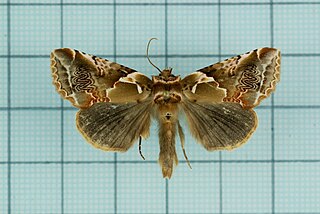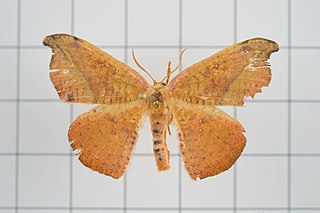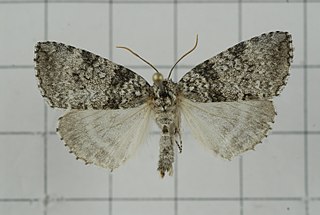
Adenophora is a genus of flowering plants in the family Campanulaceae, the bellflowers. Plants of this genus are known commonly as ladybells. Most of the species in the genus are native to eastern Asia, with a few in Europe. Many are endemic to either China or Siberia.

Habrosyne indica is a moth in the family Drepanidae. It is found from India to Taiwan and Japan.

Habrosyne petrographa is a moth in the family Drepanidae. It is found in China and Taiwan.

Oreta loochooana is a moth in the family Drepanidae first described by Charles Swinhoe in 1902. It is found in Japan, Korea, mainland China, Taiwan and the Russian Far East.

Tethea consimilis is a species of moth of the family Drepanidae first described by Warren in 1912. It is found in Asia, including the Russian Far East, Japan, Korea, Taiwan, Myanmar, Indonesia and India. The habitat consists of various types of mixed and broad-leaved forests.
Oreta hoenei is a moth in the family Drepanidae. It was described by Watson in 1967. It is found in China.
Gaurena gemella is a moth in the family Drepanidae. It is found in China and Nepal.
Habrosyne violacea is a moth in the family Drepanidae. It is found in the Russian Far East, Korea, China, Myanmar, Vietnam, Nepal and Sikkim, India.
Macrothyatira conspicua is a moth in the family Drepanidae first described by John Henry Leech in 1900. It is found in the Chinese provinces of Shaanxi, Zhejiang, Hunan, Fujian, Sichuan and Yunnan and in Taiwan.
Macrothyatira fasciata is a moth in the family Drepanidae. It was first discovered by Constant Vincent Houlbert in 1921. It is found in the following areas of China: Beijing, Shanxi, Henan, Shaanxi, Hubei, Sichuan, Yunnan, and Tibet.
Tethea longisigna is a moth in the family Drepanidae first described by Gyula M. László, Gábor Ronkay, László Aladár Ronkay and Thomas Joseph Witt in 2007. It is found in the Chinese provinces of Heilongjiang, Shaanxi, Gansu, Xinjiang, Hubei, Zhejiang, Fujian, Sichuan and Yunnan.
Toelgyfaloca circumdata is a moth in the family Drepanidae. It was described by Constant Vincent Houlbert in 1921. It is found in China in Beijing, Shanxi, Henan, Shaanxi, Gansu, Hubei, Sichuan and Yunnan.
Neotogaria flammifera is a moth in the family Drepanidae. It was described by Constant Vincent Houlbert in 1921. It is found in China and Vietnam.
Parapsestis cinerea is a moth in the family Drepanidae. It was described by Gyula M. László, Gábor Ronkay, László Aladár Ronkay and Thomas Joseph Witt in 2007. It is found in China in Henan, Shaanxi, Gansu, Zhejiang, Hubei, Guangxi, Sichuan, Jilin, Liaoning and Beijing, the Russian Far East and Korea.

Parapsestis argenteopicta is a moth in the family Drepanidae. It was described by Oberthür in 1879. It is found in the Russian Far East, Korea, Japan, Taiwan, western, north-eastern, northern and central China and Nepal. The habitat consists of various types of mixed forests and oak woods.
Parapsestis lichenea is a moth in the family Drepanidae. It was described by George Hampson in 1893. It is found in Sikkim in India, Myanmar, Thailand, Vietnam and the Chinese provinces of Henan, Shaanxi, Zhejiang, Hubei, Fujian, Sichuan, Yunnan and Tibet.
Parapsestis meleagris is a moth in the family Drepanidae. It was described by Constant Vincent Houlbert in 1921. It is found in the Chinese provinces of Jilin, Shaanxi, Gansu, Zhejiang, Fujian, Jiangxi, Hubei, Hunan, Sichuan, Guizhou and Yunnan.
Parapsestis pseudomaculata is a moth in the family Drepanidae. It was described by Constant Vincent Houlbert in 1921. It is found in the Chinese provinces of Shaanxi, Gansu, Hubei, Hunan, Sichuan and Yunnan and in Myanmar.

Parapsestis tomponis is a moth in the family Drepanidae. It was described by Shōnen Matsumura in 1933. It is found in Taiwan, Vietnam and the Chinese provinces of Henan, Shaanxi, Gansu, Hubei, Hunan, Fujian, Sichuan, Guizhou and Yunnan.

Spica parallelangula is a moth in the family Drepanidae. It was described by Sergei Alphéraky in 1893. It is found in the Chinese provinces of Shaanxi, Ningxia, Gansu, Hubei, Hunan, Guangxi, Sichuan, Chongqing and Yunnan and in Myanmar.








